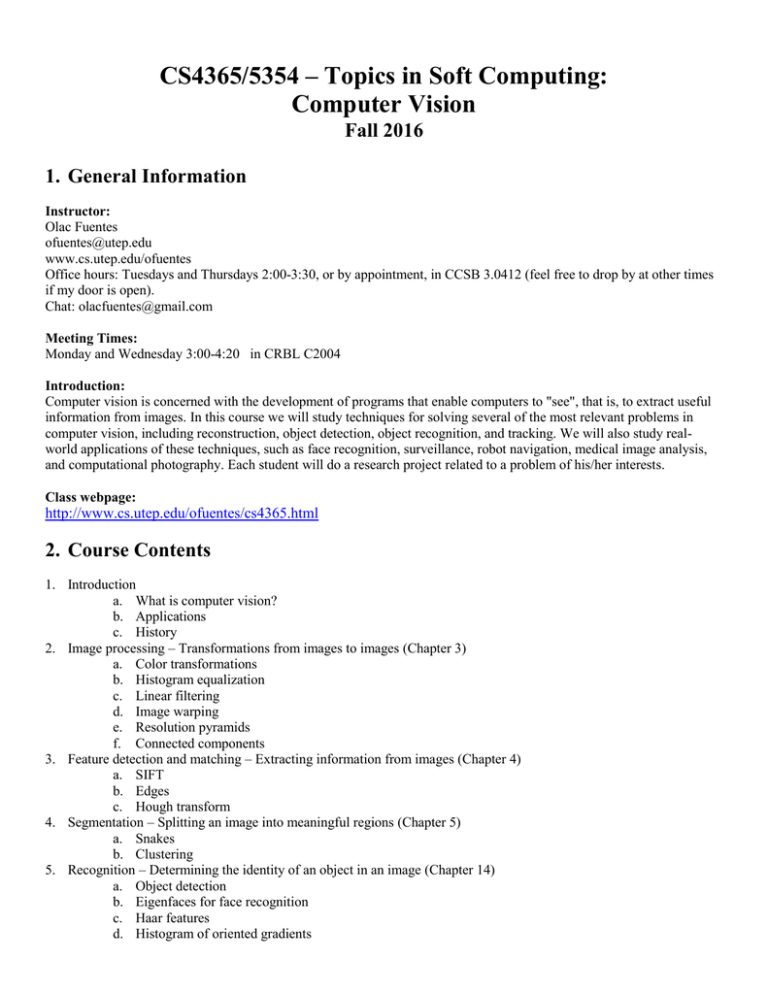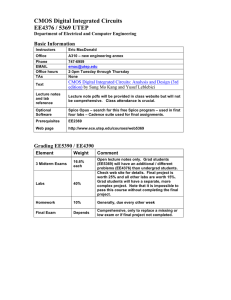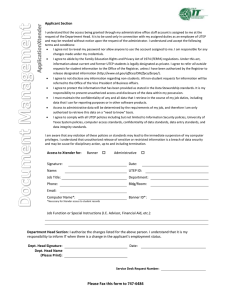CS4365/5354 – Topics in Soft Computing: Computer Vision Fall 2016
advertisement

CS4365/5354 – Topics in Soft Computing: Computer Vision Fall 2016 1. General Information Instructor: Olac Fuentes ofuentes@utep.edu www.cs.utep.edu/ofuentes Office hours: Tuesdays and Thursdays 2:00-3:30, or by appointment, in CCSB 3.0412 (feel free to drop by at other times if my door is open). Chat: olacfuentes@gmail.com Meeting Times: Monday and Wednesday 3:00-4:20 in CRBL C2004 Introduction: Computer vision is concerned with the development of programs that enable computers to "see", that is, to extract useful information from images. In this course we will study techniques for solving several of the most relevant problems in computer vision, including reconstruction, object detection, object recognition, and tracking. We will also study realworld applications of these techniques, such as face recognition, surveillance, robot navigation, medical image analysis, and computational photography. Each student will do a research project related to a problem of his/her interests. Class webpage: http://www.cs.utep.edu/ofuentes/cs4365.html 2. Course Contents 1. Introduction a. What is computer vision? b. Applications c. History 2. Image processing – Transformations from images to images (Chapter 3) a. Color transformations b. Histogram equalization c. Linear filtering d. Image warping e. Resolution pyramids f. Connected components 3. Feature detection and matching – Extracting information from images (Chapter 4) a. SIFT b. Edges c. Hough transform 4. Segmentation – Splitting an image into meaningful regions (Chapter 5) a. Snakes b. Clustering 5. Recognition – Determining the identity of an object in an image (Chapter 14) a. Object detection b. Eigenfaces for face recognition c. Haar features d. Histogram of oriented gradients e. Census transform f. Classification algorithms 6. Computational Photography (Chapters 9 and 10) a. Image stitching b. High dynamic range imaging c. Super-resolution d. Image composting 7. 3D Computer vision – Extracting 3D information from images (Chapter 11) a. Stereo correspondence b. Active illumination methods Segmentation Tracking Finding points of interest Image mosaic Contour tracking Depth extraction 3. Policies and Other Information Textbook: Computer Vision: Algorithms and Applications, Richard Szeliski. Springer 2010. Prerequisites: Face Detection CS 2302 – Data Structures or permission from instructor. Tools: OpenCV Matlab Caffe Grading: 2 Midterm exams 10% each Homework 5% Lab Assignments 30% Final exam 15% (optional, can be replaced by final project grade) Course Project 30% (3 presentations, final report) Late homework submission: Homework up to a day late will receive up to 80% of full credit, and it will not be accepted after that. Collaboration: Collaboration among students is strongly encouraged. It is OK to: Talk with other students about approaches and ideas. Get ideas and extra information from the internet, books, etc. However, it is not OK to: Share code with another student (if a piece of code is submitted by two or more students, both students are guilty of cheating, regardless of who wrote the original code). Use code acquired from an outside source (the internet, a friend, etc.) Look at another student’s code Debug another student’s code We will use software to detect plagiarized programs and take appropriate disciplinary actions if necessary. Cellular telephones are prohibited during lecture sessions. Students are required to turn off their cellular telephones before entering the classroom. Disabilities: If you feel that you may have a disability that requires accommodation, contact the Disabled Student Services Office at 747-5184, go to Room 106E Union, or email dss@utep.edu 4. Lab Submission Guidelines Lab assignments will be posted on-line. Each lab grade will be computed from the reports submitted and a 5-minute oral presentation. You must submit a printed report of every lab that includes the following items: Introduction – Description of the problem you are trying to solve Proposed solution design and implementation – How did you solve (or attempt to solve) the problem? Provide an informal, high-level description. Description of your code (not the actual code). Explain the design choices you made, including how you broke the program into modules, your user interface, input and output, etc. Experimental results – Describe the experiments you performed to test your program. The experiments must be described in a way that allows anybody to replicate them using your code. Include sample runs that illustrate your results under different types of inputs. Conclusions – Explain what you learned from the project. Appendix – Source code Reports will be graded as follows: Completeness Does your report cover all required aspects in enough detail? Clarity Are those aspects clearly explained? Depth Does the report show clear understanding of the topic covered? Language Is the report written with proper grammar and spelling? Presentation Is the formatting appropriate? Policy on late lab assignments: Lab project grades will be reduced by a factor of 8% for each working day or fraction they are late. Missing lab assignments: All labs must be submitted by the end of the semester in order to pass the class. Additionally, a student who has submitted less than 75% of the labs due by the time a midterm exam is given won’t be allowed to take that exam. 5. Standards of Conduct and Academic Dishonesty You are expected to conduct yourself in a professional and courteous manner, as prescribed by the UTEP Standards of Conduct: http://admin.utep.edu/portals/68/Standards_of_Conduct_2013-2014.pdf Academic dishonesty includes but is not limited to cheating, plagiarism and collusion. Cheating may involve copying from or providing information to another student, possessing unauthorized materials during a test, or falsifying data (for example program outputs) in laboratory reports. Plagiarism occurs when someone represents the work or ideas of another person as his/her own. Collusion involves collaborating with another person to commit an academically dishonest act. Professors are required to - and will - report academic dishonesty and any other violation of the Standards of Conduct to the Dean of Students


